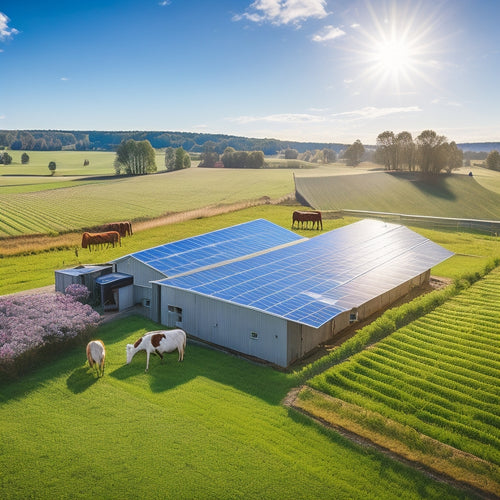
Solar System Panel Installation
Share
By installing a solar system panel, you'll greatly reduce your carbon footprint and lower your reliance on fossil fuels, revealing a cleaner and more sustainable energy future while enjoying substantial energy savings and financial benefits. With advances in technology, you can expect higher energy conversion rates above 20% and efficient power extraction through Maximum Power Point Tracking. You'll need to evaluate system sizing and cost per watt to find the right fit for your energy needs and budget. As you investigate the world of solar system panel installation, you'll uncover the complexities of performance monitoring, maintenance, and energy storage that will ultimately maximize your return on investment.
The Essentials
- Higher energy conversion rates above 20% are recommended for solar panels to maximize power output and reduce energy waste.
- Proper placement and integration with energy storage systems, like Maximum Power Point Tracking (MPPT) technology, enhance energy harvesting.
- High-quality inverters optimize energy conversion for increased power generation and ensure seamless grid integration.
- System sizing and cost evaluation are crucial, balancing cost per watt with total wattage needed for energy requirements and local building codes.
- Regular maintenance practices, such as cleaning panels, and performance monitoring are essential for peak performance and optimal energy output.
Higher Energy Conversion Rate
When you're installing a solar system panel, you want to maximize your energy output.
To achieve this, you'll need to guarantee maximum power harvesting, which involves optimizing your panel's alignment and angle to capture the most sunlight.
Shifting to solar energy can be a complex process, but professional panel installations can help guarantee a smooth and successful installation.
Maximum Power Harvesting
Maximizing your solar system panel installation for peak power collection is vital to achieving a higher energy conversion rate.
You'll want to select the right solar panel types for your specific climate and energy needs. Installation techniques, such as adjusting the panel's tilt and orientation, can also greatly influence energy output.
For instance, switching to a home solar power battery can enable you to capture and store excess energy generated by your solar panels during the day. This innovative solution allows you to power your home at night or during power outages without incurring additional costs.
Energy storage systems, like batteries, can help you collect excess energy generated during the day for use at night or during power outages. Additionally, grid integration allows you to feed excess energy back into the grid and receive credits or even revenue.
Proper maintenance practices, like regular cleaning and inspection, are essential to ensuring peak performance. Performance monitoring systems can help you track your energy production and identify areas for improvement.
By choosing a high-efficiency system, you'll not only reduce your carbon footprint but also enjoy financial incentives, such as tax credits or rebates.
Stay informed about technology advancements and consumer awareness initiatives to get the most out of your solar system panel installation.
Efficient Energy Conversion
Efficient Energy Conversion (Higher Energy Conversion Rate)
Efficient energy conversion is essential in utilizing the power of the sun. With advances in solar panel technology, you can enjoy a higher energy conversion rate, allowing you to generate more power from the same amount of sunlight. This means you'll get more bang for your buck, reducing your reliance on traditional energy sources and increasing your energy independence.
By incorporating advanced home power backup systems, such as solar battery storage, you can also maximize your renewable energy output and decrease your reliance on the grid. To achieve higher energy efficiency, your solar panels must be able to convert sunlight into electrical energy with minimal loss.
Look for solar panels with high conversion efficiency rates, typically above 20%. Additionally, verify your solar system is equipped with a high-quality inverter that can optimize energy conversion. By doing so, you'll be able to generate more power, reduce your carbon footprint, and enjoy the freedom that comes with relying on renewable energy.
With efficient energy conversion, you'll be well on your way to revealing the full potential of your solar system.
Reduced Carbon Footprint Guaranteed
By installing solar system panels, you'll greatly lower your emissions today, reducing your reliance on fossil fuels and mitigating climate change.
With the help of residential solar panels, homeowners can utilize the power of renewable energy and make a considerable impact on the environment.
As you generate clean energy, you'll be contributing to a sustainable future for generations to come.
With a reduced carbon footprint, you'll be doing your part to protect the environment while also saving on energy costs.
Lower Emissions Today
Your decision to install solar system panels is an essential step towards minimizing your reliance on fossil fuels and shrinking your carbon footprint. By utilizing renewable energy, you'll greatly reduce your energy consumption from the grid, leading to substantial energy savings.
This change towards sustainable practices not only benefits the environment but also contributes to a cleaner, healthier community.
The environmental impact of solar energy is undeniable. It's a zero-emission source of power, unlike traditional fossil fuels that release harmful pollutants into the atmosphere.
Additionally, government incentives and community support for solar panel installations are on the rise, making it an attractive option for homeowners. The installation process is straightforward, and with proper maintenance tips, your system will operate efficiently for years to come.
Financing options are also available to make the shift more accessible. Thanks to technological advancements, solar panels have become more efficient and affordable, providing you with energy independence and a reduced carbon footprint.
Clean Energy Future
Solar system panels pave the way for a clean energy future, where you can markedly reduce your carbon footprint and play an essential role in protecting the environment. By utilizing renewable technologies, you're contributing to energy independence and sustainable practices that minimize environmental impact.
| Benefits | Description | Advantages |
|---|---|---|
| Energy Independence | Reduce reliance on fossil fuels | Increased energy security |
| Sustainable Practices | Lower carbon emissions, reduce waste | Contribute to a healthier environment |
| Financial Benefits | Government policy incentives, reduced energy bills | Increased savings, improved cash flow |
With innovative solutions like energy storage and grid integration, you can optimize your energy consumption and reduce your reliance on traditional energy sources. Community initiatives and policy incentives are also driving the adoption of clean energy, making it more accessible and affordable for everyone. By investing in solar system panels, you're not only reducing your carbon footprint but also contributing to a cleaner, healthier environment for future generations.
Maximum Power Point Tracking
You're now looking to optimize energy harvesting and efficient power extraction through Maximum Power Point Tracking (MPPT).
This critical component of your solar system panel installation guarantees you're getting the most out of your panels by flexibly adjusting the operating voltage to match the maximum power point.
By leveraging sustainable power systems and reducing reliance on the electric grid, you'll not only increase energy independence but also minimize your carbon footprint.
Optimizing Energy Harvesting
As the photovoltaic (PV) panels in your solar system panel installation convert sunlight into electrical energy, their output power varies constantly due to changes in temperature, irradiance, and other environmental factors.
To enhance energy harvesting, you need to contemplate several factors during the installation process. Proper solar panel placement is vital to minimize shading, which can greatly reduce energy output. Conduct a thorough shadow analysis to identify potential obstructions and adjust the panel's tilt angle accordingly.
Energy storage systems can also be integrated to store excess energy generated during the day for use during periods of low sunlight. Guarantee seamless grid integration by selecting the right inverter for your system.
Regular maintenance practices, such as cleaning the panels, are fundamental to maintain peak performance. Weather conditions, like high temperatures, can affect energy output, so it's important to monitor your system's performance regularly.
A thorough site assessment will help you identify the best location for your solar panel installation, considering local weather patterns and environmental factors.
Efficient Power Extraction
Optimizing energy harvesting through proper solar panel placement and energy storage integration sets the stage for maximizing the power output of your solar system panel installation. Efficient power extraction is essential to guarantee you're getting the most out of your renewable energy solutions. Maximum Power Point Tracking (MPPT) technology plays a significant role in this process. MPPT controllers continuously monitor the solar panel's voltage and current output, adjusting the load to extract the maximum power available.
| Efficiency Metric | Description | Impact on Power Output |
|---|---|---|
| Fill Factor (FF) | Measures the "squareness" of the I-V curve | A higher FF (up to 0.9) means more power extracted |
| Maximum Power Point (MPP) | The point at which the solar panel produces maximum power | Accurate MPP tracking guarantees optimal energy harvesting |
| Conversion Efficiency | The ratio of DC power output to DC power input | Higher conversion efficiency means less energy wasted |
Wattage Matches Your Budget
When you're planning your solar system panel installation, you'll need to evaluate the wattage that matches your budget.
The system size matters, as it directly affects the overall cost of the installation. To maximize energy efficiency, it's crucial to assess the Photovoltaic cells and inverter systems that will help you generate clean energy.
You'll want to balance the cost per watt with the total wattage you need to meet your energy requirements.
System Size Matters
Determine your energy needs and budget to pinpoint the ideal system size. This vital step guarantees you're not undersized or oversized for your energy requirements. A system that's too small won't meet your needs, while an oversized system will waste resources and increase costs.
When determining system size, consider your daily energy usage, roof space, and local building codes. A professional installer will assess your energy needs and provide a customized system design that suits your budget. They'll also consider factors like shading, panel orientation, and inverter efficiency to maximize energy production.
During the installation process, the installer will ascertain that the system is correctly sized and configured to meet your energy needs. A well-designed system will provide you with the freedom to generate your own clean energy and reduce your reliance on the grid.
Cost Per Watt
Cost Per Watt (Wattage Matches Your Budget)
About 3.2 watts of solar power per dollar is the industry standard for a well-priced system. When evaluating the cost of your solar panel installation, you'll want to assess the cost per watt to guarantee you're getting the best value. This metric helps you compare different systems and installation companies.
Keep in mind that the cost per watt can vary depending on several installation factors, such as the type and quality of equipment, installation complexity, and local labor costs.
You'll also want to investigate available financial incentives, like tax credits and rebates, which can greatly reduce the upfront cost of your system. By factoring these incentives into your calculation, you'll get a more precise depiction of the cost per watt.
As you weigh your options, remember that a lower cost per watt doesn't always mean the best value. Be sure to evaluate the quality of the equipment, the installation company's reputation, and the system's expected performance and lifespan.
Longer System Lifespan Guaranteed
When you invest in a solar system panel installation, you're likely looking for a long-term solution that will provide you with clean energy for years to come.
That's why you'll want to contemplate extended warranty options that guarantee a longer system lifespan.
Extended Warranty Options
You've invested in a high-quality solar system panel installation, and now you're looking to maximize its lifespan. One way to do this is by opting for extended warranty options. These options provide you with additional peace of mind, ensuring that your system remains in top condition for years to come.
Here's a breakdown of what you can expect from different warranty providers:
| Warranty Provider | Warranty Coverage |
|---|---|
| Manufacturer's Warranty | 10-25 years on panels, 5-10 years on inverters |
| Extended Warranty | Up to 30 years on panels, up to 15 years on inverters |
| Service Agreement | Priority customer support, regular installation maintenance |
| Premium Warranty | Extended durability, repair options, and priority claim process |
| Third-Party Warranty | Policy differences may apply, review terms carefully |
When choosing an extended warranty option, consider factors like warranty coverage, installation maintenance, customer support, and the claim process. With the right warranty, you'll enjoy extended durability, repair options, and policy differences that work in your favor. By investing in an extended warranty, you're investing in the freedom to enjoy your solar system for years to come.
Frequently Asked Questions
How Do I Know if My Roof Is Suitable for Solar Panels?
When evaluating your roof, you'll want to contemplate its orientation, ensuring it receives sufficient sunlight, and perform a shading analysis to identify obstacles, like trees or buildings, that might impact energy production.
Are Solar Panels Resistant to Extreme Weather Conditions?
You'll be relieved to know that modern solar panels are built to withstand extreme weather conditions, boasting durability that guarantees peak performance even in harsh climates, from scorching heat to freezing temperatures and torrential rains.
Can I Install Solar Panels on My Own?
You can attempt a DIY installation, but it's essential to weigh the risks: ensuring proper electrical connections, waterproofing, and ideal panel placement to maximize solar panel benefits, which may require professional knowledge.
How Often Should I Clean My Solar Panels?
As you bask in the radiant sunlight, remember to regularly dust off the grime, allowing your solar panels to shine bright. For ideal energy harvesting, adopt cleaning techniques like soft-bristled brushes and gentle soap solutions, maintaining a frequency of every 6-12 months, depending on your local climate conditions.
Are There Any Government Incentives for Solar Panel Installation?
You're eligible for federal tax incentives and state rebates when investing in eco-friendly solutions; these benefits can greatly offset your upfront costs, giving you more freedom to choose sustainable living without breaking the bank.
Final Thoughts
As you flip the switch, your newly installed solar system panels spring to life, utilizing the sun's energy with unparalleled efficiency. With a higher energy conversion rate, you're not only reducing your carbon footprint but also saving on your electricity bill. Maximum power point tracking guarantees peak performance, while our customized solutions fit your budget like a glove. And with a longer system lifespan assured, you can bask in the warmth of sustainability for years to come, knowing you've made a brilliant investment.
Related Posts
-

What Do I Need to Know About Farm Solar Panels
When considering farm solar panels, you need to assess costs, benefits, and technical specifics. Initial investment c...
-

Solar Phone Chargers for Camping Essentials
Solar phone chargers are must-haves for your camping essentials, allowing you to stay connected while enjoying nature...
-

Designing a Green Roof for Maximum Energy Efficiency
Designing a green roof for maximum energy efficiency involves several key strategies. Start by selecting native, drou...


